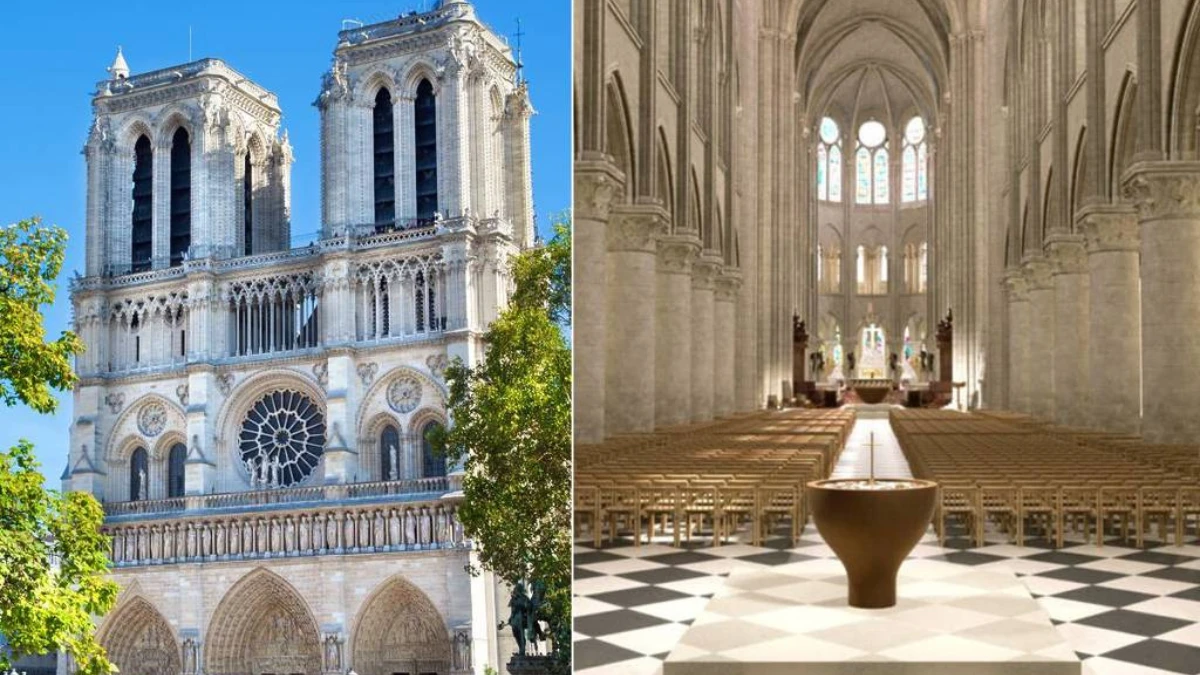Notre Dame Cathedral in Paris is one of the finest examples of French Gothic architecture.
Standing majestically on the Île de la Cité, this masterpiece has captivated architects, historians, and visitors for centuries.
Its intricate design, majestic spires, and groundbreaking structural innovations mark Notre Dame as an architectural marvel of the medieval era.
This article dives deep into the architectural elements, history, and design features of Notre Dame Cathedral while exploring its enduring legacy.
Historical Background
Construction Timeline
The construction of Notre Dame began in 1163 under the supervision of Bishop Maurice de Sully and continued for over 200 years, being completed around 1345.
Several architects worked on the cathedral, contributing to its unique blend of styles within the Gothic tradition.
The Role of Gothic Architecture
Notre Dame’s construction coincided with the peak of Gothic architecture, a style characterized by:
- Vertical emphasis
- Light-infused interiors
- Complex structural engineering
The cathedral also served as a template for other Gothic structures across Europe.
📌 Explore Notre Dame history in detail.
Exterior Architecture: Engineering Elegance
Notre Dame’s exterior is as functional as it is beautiful. Combining revolutionary Gothic innovations with profound symbolism, architects of the 12th and 13th centuries adopted techniques to keep the massive structure stable while achieving extraordinary height and lightness.
Get guided tours of exteriorFlying Buttresses
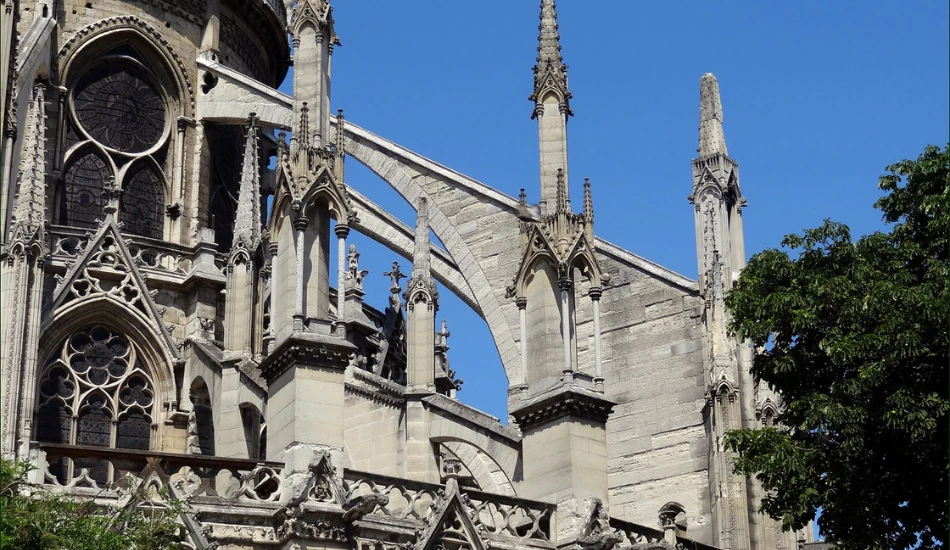
Notre Dame was one of the first buildings to use flying buttresses on such a large scale. These elegant, curved supports transfer the immense weight of the roof to external pillars, allowing for thinner walls, larger windows, and a luminous interior—a signature element of Gothic architecture.
Unlike traditional double-flight buttresses, Notre Dame’s single-flight design, which spans over the aisles, showcases the skill and foresight of its creators.
As an added benefit, the buttresses also act as ingenious rainwater drains, channeling water through decorative gargoyles and preventing damage to the delicate stonework.
The West Façade
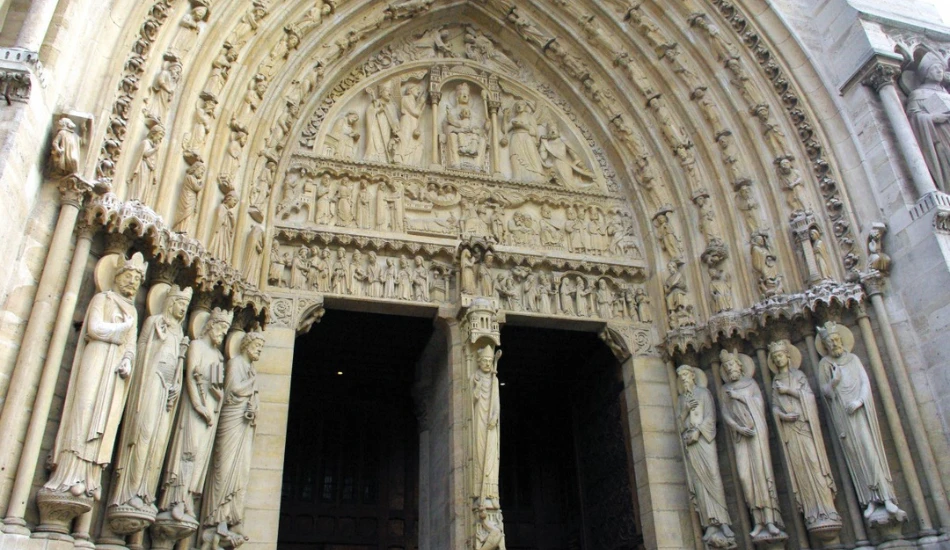
The western face of Notre Dame is a striking example of balance, artistry, and religious storytelling. Its symmetry is paired with profound symbolism, creating an unforgettable first impression.
The Three Portals: These entrances serve as visual storytellers, with intricate stone carvings depicting key biblical events:
- Portal of the Last Judgment: The largest and most elaborate, this central portal portrays the weighing of souls and scenes of heaven and hell.
- Portal of the Virgin: Depicts the life of the Virgin Mary, celebrating her role in Christianity.
- Portal of Saint Anne: Highlights Mary’s ancestry and Christ’s lineage.
The Magnificent Rose Window: Above the portals is the rose window, a circle of stained glass that illuminates the interior with radiant colors when struck by sunlight.
The Twin Towers: Flanking the portals are the twin towers, soaring to about 69 meters. Though they appear identical, one tower is slightly taller than the other—a subtle quirk that adds to the cathedral’s charm.
The South Façade and the Saint-Étienne Portal
Facing the Seine River, the Saint-Étienne Portal narrates the life of Saint Stephen, the first Christian martyr. It also pays homage to the older Saint-Étienne Cathedral, which once occupied the current forecourt.
This portal offers a quieter yet deeply historical side of Notre Dame, often overlooked by visitors.
While the cathedral is marvelous by day, visiting at night offers a completely different charm, with the illuminated facade creating a magical experience. Learn more about visiting Notre Dame at night.
Get the best exterior photos of Notre Dame
- Front Facade: View from Petit Pont or Pont Saint-Michel.
- South Side: Walk along Quai de Montebello between Pont au Double and Pont de l’Archevêché for great angles.
- Back View: Head to Pont de la Tournelle, Quai d’Orléans, or Pont Saint-Louis for stunning rear shots.
- North Side: Best seen from Rue Cloître-Notre-Dame.
💡Pro Tip: Follow a loop starting at Pont au Double, walk along the Seine, cross Pont de l’Archevêché, and return through Rue Cloître-Notre-Dame for diverse perspectives.
Interior Architecture: A Sanctuary of Light and Space
Stepping inside Notre Dame feels like entering a realm of peace and majesty. Its interior offers an experience that is both spiritual and architectural, showcasing balance, height, and light in perfect harmony.
Explore interiors at your own paceThe Nave: Vertical Grandeur
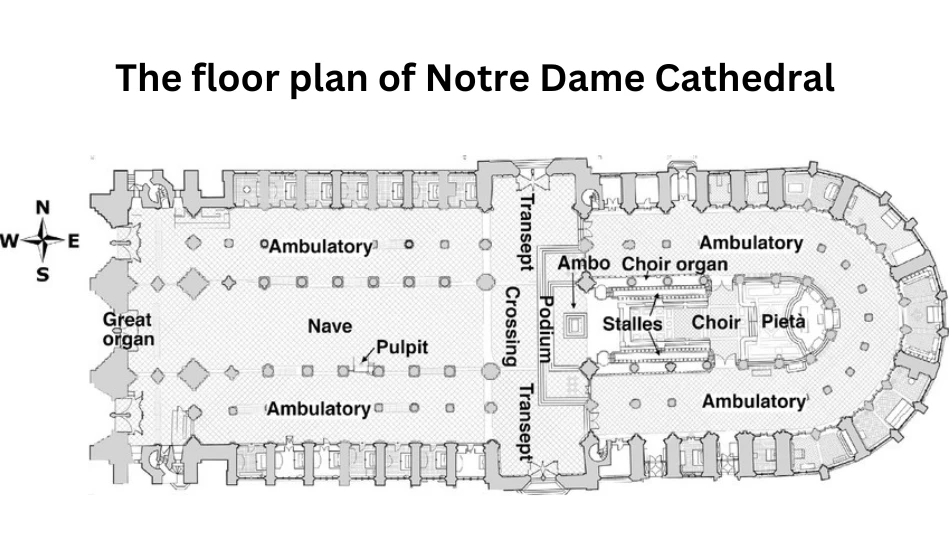
The nave, or central hall, forms the heart of the cathedral.
Spanning ten bays, it is lined with massive stone pillars that draw the eye upward, emphasizing verticality—a hallmark of Gothic design intended to inspire awe and a sense of the divine.
The ingenious use of rib vaults creates a strong yet airy ceiling, with intersecting arches that distribute weight to the supporting columns.
The result is an open, soaring space that seems to defy gravity, encouraging visitors to look heavenward.
Stained Glass Windows: Paintings in Light

Notre Dame’s stained glass windows are among its most captivating features. Covering nearly every inch of wall space, they transform sunlight into a kaleidoscope of vibrant color and ethereal light.
- The Crown Jewels: The north and south rose windows, completed in the 13th century, are masterpieces of artistry. These intricate glass designs depict saints, angels, and biblical stories in radiant hues, creating a serene and otherworldly atmosphere.
- The Magic of Light: On sunny days, the play of light and shadow across the stone floor is nothing short of magical, leaving visitors enchanted by its beauty.
👍Must read: What is inside the Cathedral
The Ambulatory and Chapels: A Path of Reflection
The ambulatory, a pathway looping behind the choir, allows visitors to circulate through the cathedral without disturbing services. Unlike most cathedrals of the period, Notre Dame features a double ambulatory supported by two rows of slender columns, providing extra space for contemplation.
- The Private Chapels: Along the aisles, chapels funded by wealthy families in the 13th century offer private sanctuaries for prayer and remembrance. Each chapel housed altars, tombs, and relics, though much of the original decor was destroyed during the French Revolution.
Iconic Details: Bells, Music, and the Spire
The Bells: Echoes of Time

Notre Dame’s bells have marked history for centuries. The most famous is Emmanuel, a giant bell weighing over 13 tons, first installed in 1685. While many other bells melted during the French Revolution, Emmanuel survived and continues to ring on important occasions.
In the 19th century, new bells were added, restoring Notre Dame’s harmonic chimes.
Today, these bells serve as powerful reminders of the cathedral’s enduring presence in Parisian life.
The Grand Organ: A Musical Marvel
Perched in the western gallery, Notre Dame’s grand organ is one of the largest and most celebrated in the world.
With over 8,000 pipes, it produces a majestic sound that fills the cathedral’s vast interior.
For centuries, the organ has accompanied services and performances, adding a musical dimension to the spiritual experience of Notre Dame.
The Spire: A Symbol of Aspiration and Loss
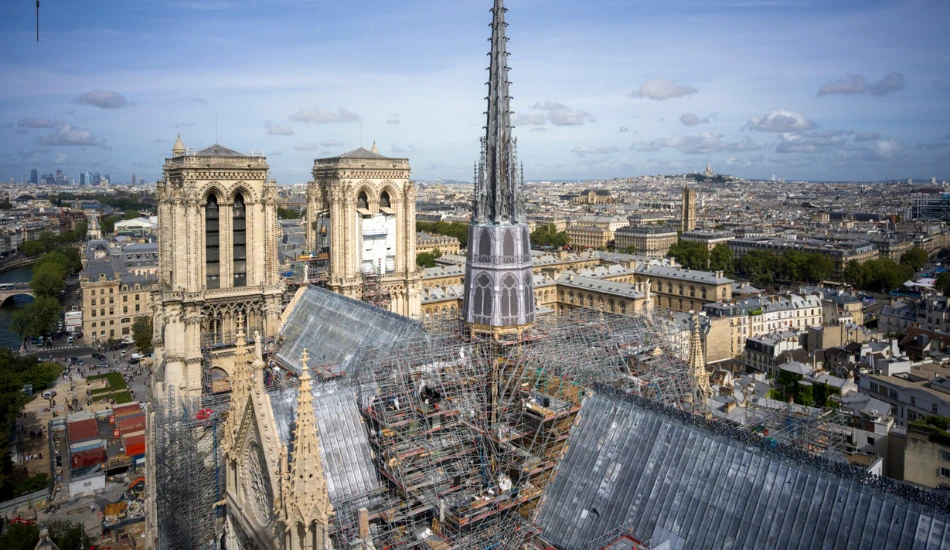
Originally built in the 13th century, Notre Dame’s spire stood as a symbol of faith reaching toward the heavens.
Over time, it deteriorated and was removed. In the 19th century, architect Eugène Viollet-le-Duc rebuilt the spire, creating a massive 96-meter (approximately 315 feet) structure adorned with statues of apostles and symbolic creatures.
Tragically, the spire and parts of the roof were destroyed in the fire on April 15, 2019. Learn all about the Notre Dame fire and ongoing restoration.
However, the statues had been removed for restoration just days before, miraculously escaping the flames.
While the cathedral has reopened for visitors, reconstruction efforts are still underway to restore the spire to its former glory using historical designs and modern techniques.
Wondering when you can explore this Gothic marvel? Check out Notre Dame Cathedral’s opening hours to plan your visit conveniently.

